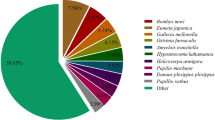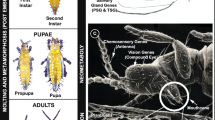Abstract
The Japanese rhinoceros beetle (Trypoxylus dichotomus [Allomyrina dichotoma]) produces the lectins allo A-I and allo A-II, which have strong N-acetyllactosamine (Galβ1-4GlcNAc)-binding activity. It has been suggested that the two lectins are formed from three subunits (α, β, and γ), with allo A-I comprising α and γ subunits and allo A-II comprising β and γ subunits. Here, we determined the cDNA sequences of these subunits using both conventional polymerase chain reaction (PCR)-cloning-sequencing and transcriptome-sequencing analyses. For the α and β subunits, one gene (locus) for each was predicted, whereas for the γ subunit, two types of cDNA sequences were obtained, which we named γ1 and γ2. These two types probably have distinct loci. Average nucleotide sequence identities among the subunits ranged from 87.6% (between α and γ1) to 92.6% (between γ1 and γ2), suggesting that they form a gene family. Although no homology was found between the sequences of allo A and other known lectin proteins in a protein database search, some unknown proteins containing the DUF3421 domain were identified. Those DUF3421 domain-encoding proteins are upregulated in the insect larval midgut. Thus, we infer that allo A genes also play an important role in larvae and that their lectin activity may have been obtained collaterally.


Similar content being viewed by others
References
Altschul SF, Madden TL, Schäffer AA, Zhang J, Zhang Z, Miller W, Lipman DJ (1997) Gapped BLAST and PSI-BLAST: a new generation of protein database search programs. Nucleic Acids Res 25:3389–3402
Atrih A, Richardson JM, Prescott AR, Ferguson MA (2005) Trypanosoma brucei glycoproteins contain novel giant poly-N-acetyllactosamine carbohydrate chains. J Biol Chem 280:865–871
Bolger AM, Lohse M, Usadel B (2014) Trimmomatic: a flexible trimmer for Illumina sequence data. Bioinformatics 30:2114–2120
Capella-Gutiérrez S, Silla-Martínez JM, Gabaldón T (2009) trimAl: a tool for automated alignment trimming in large-scale phylogenetic analyses. Bioinformatics 25:1972–1973
Cox MP, Peterson DA, Biggs PJ (2010) SolexaQA: At-a-glance quality assessment of Illumina second-generation sequencing data. BMC Bioinformatics 11:485
Dimopoulos G, Seeley D, Wolf A, Kafatos FC (1998) Malaria infection of the mosquito Anopheles gambiae activates immune-responsive genes during critical transition stages of the parasite life cycle. EMBO J 17:6115–6123
Felsenstein J (1981) Evolutionary trees from DNA sequences: a maximum likelihood approach. J Mol Evol 17:368–376
Felsenstein J (1985) Confidence limits on phylogenies: an approach using the bootstrap. Evolution 39:783–791
Gazara RK, Cardoso C, Bellieny-Rabelo D, Ferreira C, Terra WR, Venancio TM (2017) De novo transcriptome sequencing and comparative analysis of midgut tissues of four non-model insects pertaining to hemiptera, coleoptera, diptera and lepidoptera. Gene 627:85–93
Goldstein IJ, Hughes RC, Monsigny M, Osawa T, Sharon N (1980) What should be called a lectin? Nature 285:66
Grabherr MG, Haas BJ, Yassour M, Levin JZ, Thompson DA, Amit I, Adiconis X, Fan L, Raychowdhury R, Zeng Q, Chen Z, Mauceli E, Hacohen N, Gnirke A, Rhind N, di Palma F, Birren BW, Nusbaum C, Lindblad-Toh K, Friedman N, Regev A (2011) Full-length transcriptome assembly from RNA-Seq data without a reference genome. Nat Biotechnol 29:644–652
Hirai H, Umetsu K (1999) Preferable mitogenicity of beetle lectin, allo A, for the blood cell culture of macaques and its influence on apoptosis. Primates 40:597–606
Kimura S, Umetsu K, Yamashita T, Suzuki T, Arai S, Sendo F (1987) T cell mitogenicity of a novel β-D-galactoside-specific lectin from the beetle, Allomyrina dichotoma (allo A). Immunopharmacology 13:181–188
Kinjo S, Monma N, Misu S, Kitamura N, Imoto J, Yoshitake K, Ikeo K (2018) Maser: one-stop platform for NGS big data from analysis to visualization. Database 2018:bay027
Koizumi N, Imamura M, Kadotani T, Yaoi K, Iwahana H, Sato R (1999) The lipopolysaccharide-binding protein participating in hemocyte nodule formation in the silkworm Bombyx mori is a novel member of the C-type lectin superfamily with two different tandem carbohydrate-recognition domains. FEBS Lett 443:139–143
Kumar S, Stecher G, Tamura K (2016) MEGA7: molecular evolutionary genetics analysis version 7.0 for bigger datasets. Mol Biol Evol 33:1870–1874
Li H, Durbin R (2009) Fast and accurate short read alignment with burrows-wheeler transform. Bioinformatics 25:1754–1760
Li H, Durbin R (2010) Fast and accurate long-read alignment with burrows-wheeler transform. Bioinformatics 26:589–595
Robinson JT, Thorvaldsdóttir H, Winckler W, Guttman M, Lander ES, Getz G, Mesirov JP (2011) Integrative genomics viewer. Nat Biotechnol 29:24–26
Salamov AA, Nishikawa T, Swindells MB (1998) Assessing protein coding region integrity in cDNA sequencing projects. Bioinformatics 14:384–390
Sasaki K, Umetsu K, Kitano T (2020) Evolution of the gene of the lectin, Phalera flavescens agglutinin (PFA). Agri Gene 15:100098
Stamatakis A (2014) RAxML version 8: a tool for phylogenetic analysis and post-analysis of large phylogenies. Bioinformatics 30:1312–1313
Taketa K, Ichikawa E, Umetsu K, Suzuki T (1986) Allomyrina dichotoma lectin-nonreactive α-fetoprotein in hepatocellular carcinoma and other tumors: comparison with Ricinus communis agglutinin-I. Cancer Lett 31:325–331
Tavaré S (1986) Some probabilistic and statistical problems in the analysis of DNA sequences. Lect Math Life Sci 17:57–86
Thomsom JD, Higgins DG, Gibson TJ (1994) CLUSTAL W: improving the sensitivity of progressive multiple sequence alignment through sequence weighting, positions-specific gap penalties and weight matrix choice. Nucleic Acids Res 22:4673–4680
Umetsu K, Suzuki T (1977) Human hemagglutination activity observed from various invertebrate body fluids. Res Pract Forensic Med 20:36–43
Umetsu K, Kosaka S, Suzuki T (1984) Purification and characterization of a lectin from the beetle, Allomyrina dichotoma. J Biochem 95:239–245
Umetsu K, Yamashita K, Suzuki J, Yamashita T, Suzuki T (1993) Purification and characterization of an N-acetyllactosamine-specific lectin from larvae of a moth, Phalera flavescens. Arch Biochem Biophys 301:200–205
Warren IA, Vera JC, Johns A, Zinna R, Marden JH, Emlen DJ, Dworkin I, Lavine LC (2014) Insights into the development and evolution of exaggerated traits using de novo transcriptomes of two species of horned scarab beetles. PLoS ONE 9:e88364
Watanabe A, Miyazawa S, Kitami M, Tabunoki H, Ueda K, Sato R (2006) Characterization of a novel C-type lectin, Bombyx mori multibinding protein, from the B. mori hemolymph: mechanism of wide-range microorganism recognition and role in immunity. J Immunol 177:4594–4604
Yamashita K, Umetsu K, Suzuki T, Iwaki Y, Endo T, Kobata A (1988) Carbohydrate binding specificity of immobilized Allomyrina dichotoma lectin II. J Biol Chem 263:17482–17489
Yokoyama K, Sato M, Haneda T, Yamazaki K, Kitano T, Umetsu K (2014) An N-acetyllactosamine-specific lectin, PFA, isolated from a moth (Phalera flavescens), structurally resembles an invertebrate-type lysozyme. Insect Biochem Mol Biol 54:106–111
Yoshikawa K, Umetsu K, Shinzawa H, Yuasa I, Maruyama K, Ohkura T, Yamashita K, Suzuki T (1999) Determination of carbohydrate-deficient transferrin separated by lectin affinity chromatography for detecting chronic alcohol abuse. FEBS Lett 458:112–116
Acknowledgements
We thank two anonymous reviewers and the editor for their valuable comments.
Author information
Authors and Affiliations
Corresponding author
Ethics declarations
Conflict of interest
The authors declare that they have no conflict of interest.
Additional information
Publisher's Note
Springer Nature remains neutral with regard to jurisdictional claims in published maps and institutional affiliations.
Supplementary Information
Below is the link to the electronic supplementary material.
Rights and permissions
About this article
Cite this article
Tabata, M., Umetsu, K. & Kitano, T. Identification and Characterization of Genes for the Allo A Lectins in Japanese Rhinoceros Beetle (Trypoxylus dichotomus [Allomyrina dichotoma]). Biochem Genet 60, 94–105 (2022). https://doi.org/10.1007/s10528-021-10088-1
Received:
Accepted:
Published:
Issue Date:
DOI: https://doi.org/10.1007/s10528-021-10088-1




